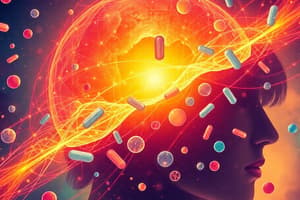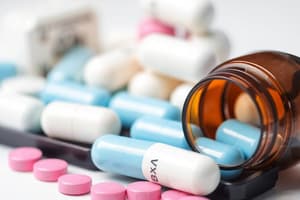Podcast
Questions and Answers
Which medication is indicated for both depression and anxiety disorders, and may lead to increased blood pressure?
Which medication is indicated for both depression and anxiety disorders, and may lead to increased blood pressure?
- Venlafaxine (correct)
- Escitalopram
- Trazadone
- Bupropion
What is a notable adverse effect of mirtazapine that is not commonly associated with most SSRIs?
What is a notable adverse effect of mirtazapine that is not commonly associated with most SSRIs?
- Weight gain (correct)
- Sedation
- Constipation
- Nausea and vomiting
Which of the following is a key feature of bupropion that differentiates it from other antidepressants?
Which of the following is a key feature of bupropion that differentiates it from other antidepressants?
- It is contraindicated in patients with anxiety disorders.
- It acts as a serotonin reuptake inhibitor.
- It increases the risk of seizures at higher doses. (correct)
- It has no effect on norepinephrine levels.
Duloxetine is often used for treating which of the following conditions apart from depression?
Duloxetine is often used for treating which of the following conditions apart from depression?
What distinguishes the mechanism of action of SSRIs like escitalopram from that of mirtazapine?
What distinguishes the mechanism of action of SSRIs like escitalopram from that of mirtazapine?
What is a key consideration when prescribing tricyclic antidepressants (TCAs)?
What is a key consideration when prescribing tricyclic antidepressants (TCAs)?
What effect does mirtazapine have on patients compared to SSRIs?
What effect does mirtazapine have on patients compared to SSRIs?
Which of the following properties is true regarding bupropion?
Which of the following properties is true regarding bupropion?
What is an important guideline when prescribing serotonin/norepinephrine reuptake inhibitors (SNRIs)?
What is an important guideline when prescribing serotonin/norepinephrine reuptake inhibitors (SNRIs)?
How do selective serotonin reuptake inhibitors (SSRIs) primarily work in the brain?
How do selective serotonin reuptake inhibitors (SSRIs) primarily work in the brain?
What is a significant adverse effect associated with tricyclic antidepressants (TCAs)?
What is a significant adverse effect associated with tricyclic antidepressants (TCAs)?
What is a common adverse effect of mirtazapine?
What is a common adverse effect of mirtazapine?
Which mechanism is involved in bupropion's action?
Which mechanism is involved in bupropion's action?
Which SNRI can increase blood pressure at higher doses?
Which SNRI can increase blood pressure at higher doses?
What is a key prescribing consideration for citalopram and escitalopram?
What is a key prescribing consideration for citalopram and escitalopram?
What is the maximum recommended dose of mirtazapine?
What is the maximum recommended dose of mirtazapine?
Which TCA has a lower risk of side effects compared to others?
Which TCA has a lower risk of side effects compared to others?
What should be monitored when prescribing duloxetine?
What should be monitored when prescribing duloxetine?
Which effect does trazodone primarily have?
Which effect does trazodone primarily have?
What unique feature does fluoxetine have compared to other antidepressants?
What unique feature does fluoxetine have compared to other antidepressants?
Which of the following is an adverse effect associated with bupropion?
Which of the following is an adverse effect associated with bupropion?
What distinguishes levomilnacipran among SNRIs?
What distinguishes levomilnacipran among SNRIs?
Which of the following SSRIs is contraindicated when creatinine clearance is less than 20 mL/min?
Which of the following SSRIs is contraindicated when creatinine clearance is less than 20 mL/min?
Which medication is recognized as a strong contraindication for bupropion?
Which medication is recognized as a strong contraindication for bupropion?
Flashcards
Black Box Warning for Antidepressants
Black Box Warning for Antidepressants
Increased risk of suicidal thoughts and actions in children, adolescents, and young adults (18-24) when taking antidepressants, seen in short-term studies.
Antidepressant Classes
Antidepressant Classes
Types of antidepressants include SSRIs, SNRIs, atypical antidepressants, TCAs, and MAOIs.
SSRI MOA
SSRI MOA
SSRIs block the reabsorption of serotonin in the brain, leading to more serotonin available at the synapses.
SSRI Adverse Effects
SSRI Adverse Effects
Signup and view all the flashcards
SSRI Management
SSRI Management
Signup and view all the flashcards
Venlafaxine (Effexor) indication
Venlafaxine (Effexor) indication
Signup and view all the flashcards
Bupropion (Wellbutrin) for MDD
Bupropion (Wellbutrin) for MDD
Signup and view all the flashcards
SNRIs: Non-antidepressant effects
SNRIs: Non-antidepressant effects
Signup and view all the flashcards
Mirtazapine's (Remeron) Unique Feature
Mirtazapine's (Remeron) Unique Feature
Signup and view all the flashcards
Mirtazapine's (Remeron) Primary Action
Mirtazapine's (Remeron) Primary Action
Signup and view all the flashcards
SIADH
SIADH
Signup and view all the flashcards
Discontinuation Syndrome
Discontinuation Syndrome
Signup and view all the flashcards
SSRI
SSRI
Signup and view all the flashcards
SNRI
SNRI
Signup and view all the flashcards
Citalopram (Celexa®)
Citalopram (Celexa®)
Signup and view all the flashcards
Escitalopram (Lexapro®)
Escitalopram (Lexapro®)
Signup and view all the flashcards
Fluoxetine (Prozac®)
Fluoxetine (Prozac®)
Signup and view all the flashcards
Paroxetine (Paxil®)
Paroxetine (Paxil®)
Signup and view all the flashcards
Sertraline (Zoloft®)
Sertraline (Zoloft®)
Signup and view all the flashcards
Venlafaxine (Effexor®)
Venlafaxine (Effexor®)
Signup and view all the flashcards
Desvenlafaxine (Pristiq®)
Desvenlafaxine (Pristiq®)
Signup and view all the flashcards
Duloxetine (Cymbalta®)
Duloxetine (Cymbalta®)
Signup and view all the flashcards
Mirtazapine (Remeron®)
Mirtazapine (Remeron®)
Signup and view all the flashcards
Bupropion (Wellbutrin®)
Bupropion (Wellbutrin®)
Signup and view all the flashcards
Trazodone (Desyrel®)
Trazodone (Desyrel®)
Signup and view all the flashcards
Study Notes
Central Nervous System Medications
- Presented by Elizabeth Cohen, PharmD BCPS
- Objectives include reviewing mechanisms of action and adverse effects of commonly used CNS agents.
- Identifying important counseling points for patients prescribed CNS agents.
- Developing an optimal psychotropic regimen considering patient and medication specific characteristics.
- Summarizing clinically significant drug interactions, key monitoring parameters, and contraindications for CNS agents.
Neurotransmitters
- GABA and Glycine are major inhibitory neurotransmitters in the CNS.
- Glycine is primarily found in the spinal cord and brainstem.
- GABA is present throughout the CNS.
- Glutamate is a major excitatory neurotransmitter in the CNS.
- Glutamate interacts with several receptors: AMPA (all neurons), KA (hippocampus, cerebellum, spinal cord), and NMDA (all neurons in CNS).
- NMDA receptors are a key pharmacological target of glutamate.
- Serotonin (5-HT) has many pathways originating from the raphe or midline region of the pons/upper brainstem.
- Serotonin plays a role in perception, mood, anxiety, pain, and temperature regulation
- Norepinephrine (NE) is an α₁, α₂, β₁ agonist with little β₂ activity.
- NE is found in the locus caeruleus (LC) or lateral tegmental area.
- NE impacts vasoconstriction, tachycardia, increased cardiac output, peripheral resistance, and hypertension.
- Dopamine (DA) has various pathways with different functions:
- Mesocortical: Important for higher-order cognitive functions.
- Mesolimbic: Involved in the reward pathway.
- Nigrostriatal: Regulates movement.
- Tuberoinfundibular: Regulates prolactin.
- Acetylcholine (ACh) interacts with muscarinic and nicotinic receptors, having both excitatory and inhibitory effects.
- Presynaptic nicotinic receptors regulate glutamate, 5-HT, GABA, DA, and NE release in the CNS.
- ACh is hydrolyzed through acetylcholinesterase (AChE).
- AChE inhibitors (e.g., neostigmine, physostigmine, donepezil) increase ACh levels.
Cholinergic Effects/Toxidrome
- Cholinergic activation causes various effects (DUMBELS):
- Diarrhea, Urination, Miosis (constricted pupils), Bronchoconstriction/bradycardia, Emesis (vomiting), Lacrimation (tearing), Salivation/sweating.
- Anticholinergic effects have the opposite actions (ACHOES) -Dry mouth, blurred vision, confusion, constipation, urinary retention.
CNS & Psychiatric Medications
- Overview of medications:
- Antidepressants
- Antipsychotics
- Mood Stabilizers
- Anxiolytics
Antidepressants
- Treatment of Major Depressive Disorder (MDD) includes pharmacotherapy, psychotherapy, and somatic therapies.
- Pharmacotherapy effectiveness is generally comparable across antidepressant classes.
- Treatment decisions consider comorbid conditions, anticipated side effects, and patient preference.
- Antidepressants carry a black box warning for increased risk of suicidal thinking and behavior in young adults (18-24), with major depressive disorder and other psychiatric disorders in short-term studies.
- Selective serotonin reuptake inhibitors (SSRIs), Serotonin/norepinephrine reuptake inhibitors (SNRIs), atypical antidepressants, Tricyclic antidepressants (TCAs), and Monoamine oxidase inhibitors (MAOIs).
Antipsychotics
- Dopamine pathways in the brain are a target of antipsychotics.
- Blockade of dopamine receptors can result in adverse effects, including worsening negative symptoms, increased prolactin release, or extrapyramidal symptoms (EPS)
- First-generation antipsychotics (FGAs) are potent D2 receptor antagonists and have various side effects and a higher risk of EPS.
- Second-generation antipsychotics (SGAs) block D2 and 5-HT2A receptors.
- SGAs have a lower risk of EPS but other potential side effects exist.
- Clozapine is a SGA reserved for treatment-resistant cases; registration with a REMS program is required and frequent blood monitoring is necessary.
Mood Stabilizers
- Lithium is a monovalent ion, almost entirely eliminated by the kidneys.
- Lithium has a narrow therapeutic index and toxicity can occur at doses above 1.2 mEq/L.
Anxiolytics
- Benzodiazepines (BDZs) bind to the gamma subunit of the GABAA receptor.
- BDZs alter the frequency of channel opening, increasing chloride ion conductance and inhibiting action potentials.
- Alternative anxiolytics, such as hydroxyzine, gabapentin, pregabalin, and buspirone, have different mechanisms of action and potential side effects.
Additional Notes
- Many drug interactions and potentially serious adverse effects are possible, consult with a physician or pharmacist.
- Detailed information regarding specific drugs and their uses often includes detailed information on dosage, mechanism of action, potential side effects, and various other parameters on an individual level.
Studying That Suits You
Use AI to generate personalized quizzes and flashcards to suit your learning preferences.




